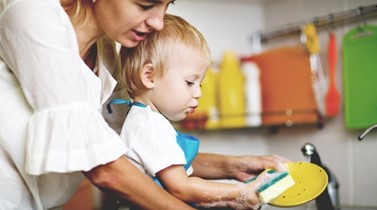Breathing un-easy: kids & colds

Wiping little runny noses is part and parcel of parenthood, especially in winter. Paediatrician Anne Tait sheds light on respiratory tract infections and why young kids are so susceptible.
Respiratory are the most common infections in children, with most toddlers going through six to twelve tract infections (RTIs) babies and RTIs each year. Not that that makes them any easier to deal with! A simple runny nose (the technical term for which is coryza) in big people can cause days, even weeks, of symptoms in young children. Sometimes it can seem like your young child no sooner gets over one bug before they are then battling another. This cycle of sickness can cause concern, and as with all things in medicine, it is important to recognise the realms of normal and also the ‘red flags’ indicating more serious problems.
What is a respiratory tract infection?
An RTI is any infection (viral or bacterial) where the bug infects the mucosa lining the upper and/or lower respiratory tract. The spectrum of an RTI can be anywhere from a simple runny nose through to severe pneumonia. In medicine, we tend to try and divide an RTI into either an upper respiratory tract infection (ie ear/throat infection or a cold) or a lower respiratory tract infection (ie bronchiolitis or pneumonia).
With regards to colds, this is where the nasal mucosa gets infected by a virus. Up until recently, we didn’t have any reliable tests to determine which bug was causing the trouble, but now – in the hospital environment – we have access to polymerase chain reaction (PCR) tests on coryza (in other words, snot. Yes, we actually test snot) to screen for various viruses. A PCR doesn’t change any management of RTIs but it does give us an answer as to what is going on. While “it’s only a virus” is a common assumption concerning sore throats and runny noses, viral infections can be severe, particularly in very young babies or children with other medical conditions that render them vulnerable.
Handle with care
A respiratory tract infection can cause a child to be very miserable, suffering breathing difficulty, fevers, cough, reduced oral intake, and ear or throat pain. It is always wise to get a child reviewed by a doctor if a caregiver has any concerns, however, antibiotics are only occasionally prescribed for upper respiratory tract infections, and are generally, in my opinion, over-prescribed. In the absence of an antibiotic prescription, some parents would then question the need for medical review, however, reassurance is an important part of medical care and sometimes time in hospital might be needed to get the child back on their feet. In addition, other infections may mimic what appears to be a simple RTI, so it is important to get a child reviewed if there are any doubts about the diagnosis.
I also tell parents that a medical review is a ‘snapshot in time’, in that it does not predict the future. Children can get sick quickly, and if a parent is concerned, they need to go and see their GP or urgent doctor. Equally, if they aren’t reassured, then they can always get a second opinion.
Thankfully, however, most children get better with supportive care at home, which usually entails plenty of TLC, small and frequent servings of healthy food and drink, and where appropriate, pain relief specifically formulated for children.
Breathe uneasy
Lower RTIs are when the infection is in the lungs. Most cases are still viral in origin, but secondary bacterial infections do occur. It can be difficult to determine between viral and bacterial pneumonia and often
antibiotics are prescribed.
Children under two frequently get bronchiolitis, a viral-induced wheezing illness. It is not asthma, but does sound and look like asthma. Unfortunately, there are very few effective treatments for bronchiolitis, despite many clinical trials looking into this. Supportive care is the mainstay, with very unwell children needing admission to hospital for oxygen and/or feeding support, if required.
Some children are more vulnerable. Risk factors for acute illness severity include:
● Young age (ie less than six months old)
● Infants who were born preterm
● Other medical conditions (ie lung or congenital heart disease)
● Immunodeficiency
● Poverty, damp cold houses, overcrowding, parental smoking
There are also red flags to be aware of, as these indicate the need for medical review:
● Parental concern
● Difficulty breathing (ie fast breathing, sucking in sides of chest, struggling to breathe)
● Difficulty with feeding (less than 50% of normal volumes)
● Vomiting
● Reduced wet nappies
● High fevers
● Irritable and/or lethargic
● Stopping breathing/pauses in breathing
Recovery time
"How long will it take for my child to get better?" is a common question from parents, and duration of symptoms is a very important concern. There are a variety of views about this in medical literature. A systematic review of studies looking at symptom duration was published in the British Medical Journal in 2013 and showed that 90% of children were better after the following periods of time:
● Common cold ..................15 days
● Ear infection .......................7-8 days
● Sore throat ..........................2-7 days
● Croup ..................................2 days
● Bronchiolitis .........................21 days
● Acute cough .....................25 days
Let’s talk treatment
For the vast majority of children, especially those with upper respiratory tract infections, the mainstay of treatment is supportive care at home, as previously mentioned. Antibiotics do not help viruses and are never prescribed for a common cold, most sore throats, most ear infections and croup. They are also generally not prescribed for bronchiolitis or short duration cough. Antibiotics can result in side effects such as diarrhoea and rashes. More importantly, there is the increasing concern regarding resistance of bacteria to antibiotics, and also the effects on the gut microbiome.
Indications for antibiotics include:
● Bilateral ear infection in children under two years of age
● Acute ear infection* with discharge from the ear
● Acute sore throat with more than three Centor criteria (eg tender lymph nodes, fever, no cough, risk of rheumatic fever)
● Proven pneumonia
● Systemically unwell children with complex medical conditions
*Acute ear infection means a bulging red eardrum with fluid behind the drum, not a simple red eardrum.
Prevention is better than cure
This is a particularly important point. While children are prone to getting sick due to their immature immune system, prevention is still important as frequent RTIs can have long-term consequences in some children, not to mention the impact on families.
Teaching young children (and adults) how to cough and sneeze into a tissue to minimise the spread of germs, and quarantining sick people are the most effective measures to prevent illnesses.
Avoiding house-overcrowding, cold and damp houses, and smoke exposure is also important. Eating a well-balanced diet, with plenty of fruit and vegetables, is always recommended. Immunisation (including pneumococcal and flu vaccination) is also important. Young children and the elderly have the highest rates of influenza, and influenza causes significant disease.
Virus particles from sneezing or coughing can stay on surfaces for some time, so handwashing is also a simple prevention measure. Wash your hands frequently, especially before you touch babies or children, if you are unwell.
Red flags for medical review of recurrent symptoms include:
● Persistent moist cough for longer than a month's duration
● Recurrent significant respiratory tract infections (ie frequent ear infections, pneumonia, tonsillitis)
● Other recurrent infections (ie fungal skin infections, boils, abscesses)
● Growth concerns
● Parental concern
Bless you
Parents should always seek review by their GP or urgent doctor if they have any concerns, or they feel that their child is getting worse. Repeated clinical review may be needed, particularly if a child isn’t improving and/or their symptoms are worsening. Some symptoms, like a cough or coryza, can last for up to three weeks. Antibiotics will generally not shorten the duration of these symptoms.
RTIs are a common childhood problem, and something all children are going to go through at some point. Most simply require supportive care at home – in other words, cuddling up on the couch, lemon and honey drink at the ready – accepting the old adage, ‘this too shall pass’.
Dr Anne Tait is a general paediatrician employed at Starship Children’s Hospital who also works in private practice at Auckland Medical Specialists. She has an interest in all areas of children’s health and wellbeing.

AS FEATURED IN ISSUE 34 OF OHbaby! MAGAZINE. CHECK OUT OTHER ARTICLES IN THIS ISSUE BELOW
















